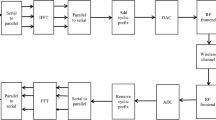Abstract
Code-Division Multiple-Access (CDMA) systems are interference limited, and therefore efficient interference management is necessary to enhance the performance of a CDMA system. In this paper, a successive beamforming (spatial filtering), linear decorrelating MultiUser Detection (MUD, temporal filtering) and diversity reception structure for uplink multicarrier Direct Sequence CDMA (DS-CDMA) system with antenna array are proposed. By beamforming, the antenna array suppresses interference according to the distinct array signature. Subsequently, linear decorrelating MUD is applied to separate the signals of different users and eliminate Multiple Access Interference (MAI). Finally, the decorrelated signals at different subcarriers that belong to the same user are combined to achieve frequency diversity. Simulation results show that the proposed structure offers significant Bit Error Rate (BER) performance improvement by successively exploiting the space-time-frequency processing.
Similar content being viewed by others
References
R. Prasad, S. Hara. An overview of multi-carrier CDMA. IEEE Commun. Magazine, 35(1997)12, 126–133.
F. Naguib, A. Paulraj. Performance of wireless CDMA with M-ary orthogonal modulation and cell site antenna arrays. IEEE JSAC, 14(1996)9, 1770–1783.
J. Chen, W. Yang. Performance of antenna array MC DS-CDMA system. in Proc. Global Mobile Congress, Shanghai, China, Oct. 2004, 610–615.
S. Verdu. Minimum probability of error for asynchronous Gaussian multiple-access channels. IEEE Trans. on IT, IT-32(1986)1, 85–96.
S. Miller, B. J. Rainbolt. MMSE detection of multicarrier CDMA. IEEE JSAC, 18(2000)11, 2356–2362.
J. Namgoong, T. F. Wong, J. S. Lehnert. Subspace multiuser detection for multicarrier DS-CDMA. IEEE Trans. on Commun., 48(2000)11, 1897–1908.
X. Wang, H. V. Poor. Space-time multiuser detection in multipath CDMA chanels. IEEE Trans. on SP, 47(1999)9, 2356–2374.
B. Papadias, H. Huang. Linear space-time multiuser detection for multipath CDMA channels. IEEE JSAC, 19(2001)2, 254–264.
R. Lupas, S. Verdu. Linear multiuser detectors for synchronous code-division multiple access channels. IEEE Trans. on IT, IT-35(1989)1, 123–136.
Author information
Authors and Affiliations
Corresponding author
Additional information
Supported by the National Natural Science Foundation of China (No.60572036) and Open Research Fund of National Mobile Communications Research Laboratory, Southeast University, China.
Communication author: Yang Wei, born in 1964, male, Ph.D., associate professor. School of Electronics and Information Engineering, Beijing Jiaotong University, Beijing 100044, China.
About this article
Cite this article
Yang, W., Chen, J., Tan, Z. et al. Successive beamforming, multiuser detection and diversity reception for multicarrier DS-CDMA system with antenna array. J. of Electron.(China) 24, 607–612 (2007). https://doi.org/10.1007/s11767-006-0010-z
Received:
Revised:
Issue Date:
DOI: https://doi.org/10.1007/s11767-006-0010-z
Key words
- Antenna array
- Multicarrier Direct Sequence Code-Division Multiple-Access (DS-CDMA)
- MultiUser Detection (MUD)
- Diversity




